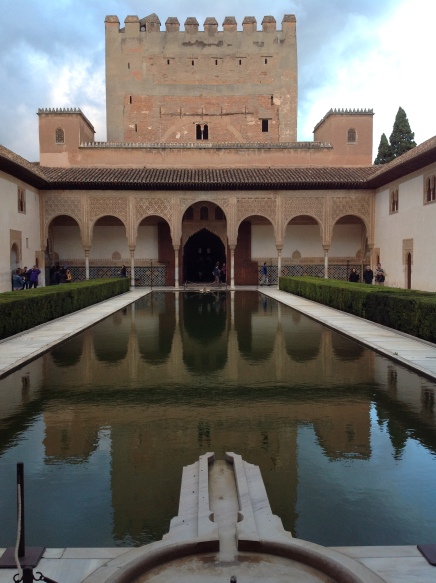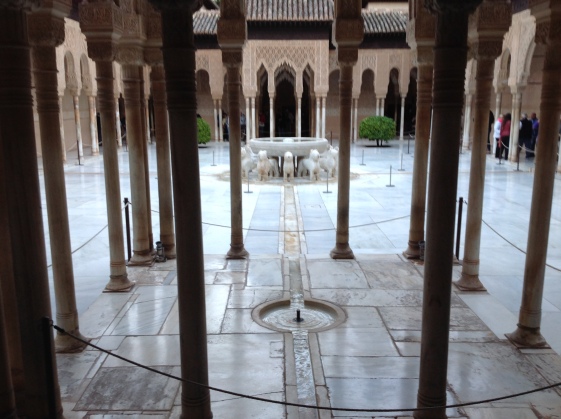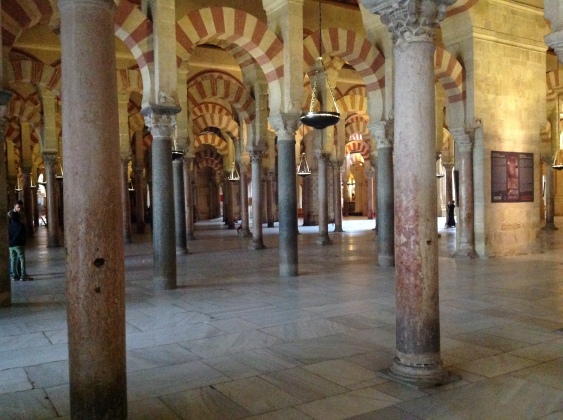To understate the obvious (double whammy!) Arab and Western cultures have some…difficulties understanding each other. But don’t worry–I can totally fix this. Yes, it’s true that I’m completely untrained in anthropology or sociology, and have done zero structured research. Minor details. The important thing is that I’m fairly well acquainted with Hollywood and Riyadh, two cities of about the same age, each functioning as the poster child for its cultural values. And I’ve been to southern Spain, where the two places mashed up before either one was ever imagined. It’s all you need.
This is a Hollywood neighborhood:
This is a Riyadh neighborhood:
The climate is similar enough. You could use the same landscaping, (though the Hollywood houses would be well advised to ditch the grass). Neither place needs to design around heavy rain or snow. Air conditioning is important. Both ought to xeriscape to conserve water.
But these pictures make a stark point about the idea that architecture and urban planning are about more than climate. They reflect values–the way people live and want to live.
American residential neighborhoods are built around an ideal of community life, where children play outside and neighbors borrow sugar from each other. Great value is placed in “curb appeal,” which is the extra $10,000 that passers-by attribute to you and your house based on how much money and leisure time you’ve put into your visible landscaping. If you add porch furniture accented with comfortable pillows (plus potted flowers? an icy drink?) you can ensure they also envision you, living a perfect life.
Saudi cities are built around an ideal of family life, where husband, wife, and children enjoy perfect privacy, where children play without parental worry, where adults can enjoy use of the entire property without prying eyes. Once the (always opaque) front gate is closed, you’re in your own private kingdom. Fountains, plants, a roller rink–do whatever you like in there. Bars on windows (lowers, at least) double the sense of security inside, and small windows minimize the heat. What is there to look at outside, anyway?
This is not just a Saudi thing. The traditional house in Morocco is referred to as a “riad,” which I understand is the Arabic word for “garden.” (There’s no standardized method for translating Arabic to Latin spelling, so there’s no special reason why the city and the house are spelled differently.) It is built in a square, with all the rooms facing an interior courtyard rather than the street or the neighbors. Walled, internally-facing homes are the norm throughout the Middle East and North Africa.
But let’s back up a second–when I said “Hollywood,” you weren’t picturing the photo above, were you? You imagined something more like this:
 Oh, that’s right. The Real Housewives of Beverly Hills, puttin’ it all out there:
Oh, that’s right. The Real Housewives of Beverly Hills, puttin’ it all out there:
And I mean ALL. Boobs, personal problems, how many bathrooms you have, nothing is private. Push it out, plump it up, bling it to the max, arch that back. If you’ve got it, flaunt it. Why have it if you don’t use it?
News flash, Westerners: These are uniquely Western (and particularly American) sentiments. The ideal Saudi woman, by contrast, looks like this:
 Okay, the different styles of house, the different styles of dress…are we getting anywhere?
Okay, the different styles of house, the different styles of dress…are we getting anywhere?
Now, off to Spain. Anciently, it had your cave people, then your Iberians and Celts, then the Romans. Then Rome collapsed, and Spain joined the rest of Europe by getting all Dark-Agey and smelly. Starting in the early 700s, the expanding Islamic empire made the short leap from Northern Africa to Spain. And stayed. Things eventually settled down, which, given the nice weather and plentitude of delicious things to eat, shouldn’t be surprising. Muslim Arabs ruled, and Jews and Christians coexisted with subordinate but protected status. Cordoba, in southern Spain, became the largest, richest, smartest, and fabulousest city in Western Europe.
But internal tensions (surprise!) between the Middle Eastern Arabs and African Berbers eventually weakened Muslim rule, and the last Muslims fell to the Christian armies of Ferdinand and Isabella in 1492. The conquerors did what conquerors do, which is bulldoze the symbols of power of the previous rulers, but THANK GOODNESS they didn’t bulldoze everything. Turns out those Moorish palaces were awesome enough that the new guys said, “Hey, I could live like this.”
Well, gosh. To save a buck, so could I:

 Okay, I could seriously unload some vacation pictures on you here, but I’ll keep it to the most pertinent. What you’re looking at are interior courtyards at the Alcazar of Seville (top), then the Alhambra in Granada (middle and bottom). This is what the Alhambra looks like from outside:
Okay, I could seriously unload some vacation pictures on you here, but I’ll keep it to the most pertinent. What you’re looking at are interior courtyards at the Alcazar of Seville (top), then the Alhambra in Granada (middle and bottom). This is what the Alhambra looks like from outside:
 Walls. Pretty walls, but walls. The Arabic castles were built around the idea that the most precious things are the most personal ones, and are kept deepest inside. Private chambers are not in a wing with a nice view (a la Versailles), but in the center, facing inward. The outside gate is where strangers come. Guests and footmen might come inside the gate, but the footmen will go no further. Minor dignitaries might come one courtyard further in. More important ones one more. The center one is for family.
Walls. Pretty walls, but walls. The Arabic castles were built around the idea that the most precious things are the most personal ones, and are kept deepest inside. Private chambers are not in a wing with a nice view (a la Versailles), but in the center, facing inward. The outside gate is where strangers come. Guests and footmen might come inside the gate, but the footmen will go no further. Minor dignitaries might come one courtyard further in. More important ones one more. The center one is for family.
And then you get to Cordoba, the former capitol of Moorish Spain. On the site of a temple to the Roman God Janus, then a Visigothic Christian church dedicated to St. Vincent, a grand mosque was built over the years between 787 and 984, intended to rival Mecca in significance. The interior space is vast–according to the tourist pamphlet it could accommodate up to 22,000 worshipers praying at one time.
 The rows and rows of columns spread out in every direction like palm trees with their fronds knitted together overhead. The interior feels spacious, but enclosed. If you’re a person prone to reverence, you’ve just found your happy place.
The rows and rows of columns spread out in every direction like palm trees with their fronds knitted together overhead. The interior feels spacious, but enclosed. If you’re a person prone to reverence, you’ve just found your happy place.
But the Christian conquerors, while exceedingly happy to occupy an Arab castle, were never going to let a giant mosque go untouched. Edge spaces were turned into sumptuous side chapels, the main floor area was left largely open, and in the center, a cathedral was built. I mean inside the mosque, seriously, they busted out the 30′ ceiling and built a 130′-high cathedral.



 Okay, Christianity, as your friend, with nothing but your best interests at heart and only because nobody else seems to be willing to tell you, I have to say you look ridiculous in that outfit. That cathedral is the religious equivalent of dropping the Real Housewives down for a photo shoot in the middle of a zen garden.
Okay, Christianity, as your friend, with nothing but your best interests at heart and only because nobody else seems to be willing to tell you, I have to say you look ridiculous in that outfit. That cathedral is the religious equivalent of dropping the Real Housewives down for a photo shoot in the middle of a zen garden.
But that up-in-your face contrast is a mite instructive. The idea expressed in the mosque is that God is intimate, quiet, and close. The idea expressed in the cathedral is that God is powerful, grand, and miles above you. The Catholic church of the Middle Ages made ostentatious displays of wealth to evoke the power and majesty of God, and, coincidentally, that of the church. Anybody who can sling that amount of gold around and employ that many hangers-on is not to be messed with. You know,
Hey look! Kim and Kanye! We’re back to Hollywood. (LAX, to be precise.) The thousand-year jump wasn’t all that big, now was it?
The most fundamental way in which the West and the Arabic world each think the other is straight NUTS is in how we present ourselves to outsiders. The Western ethos is one of putting forward an image of success, attractiveness, wealth, confidence, and power. The more assets you can display, the less likely somebody is to mess with you. “I have lawyers! I have connections! Everyone is paying attention to me!” The Middle Eastern ethos is one of putting forward an image of humility and unremarkableness. The more thoroughly your assets are hidden away, the less likely somebody is to become envious of what you’ve got and mess with you. “Pretty girls, cover yourselves! Don’t let anybody know!”
(That said, don’t you worry–Westerners do a fine job hiding humbling vulnerabilities behind a showy display. And Saudis do the same in reverse, donning the humble national dress while accessorizing with expensive labels and watches and shoes and cars.)
But underneath all the camouflage is a universal undergarment of fear that everyone on earth, in every country and culture, sleeps and wakes in. It may be reversible, and we wear it inside out from each other, but one way of wearing it is not more valid, more effective, or more ridiculous than another. We all fear losing what we have and value. We fear scarcity and loneliness and defeat. We fear each other. Understanding that, by itself, can make things less frightening.
On an episode of Project Runway a couple of years ago, a designer wrestling with a look that wasn’t working decided to turn the jacket backwards. The result wound up being the winning look.
Flipping over what you know, what you’ve always done, what you expect isn’t hard, but it requires imagining that it’s even possible. The result can change your perspective forever. Which, in fashion terms, is pretty almighty fabulous.
*Update: I just saw an article in Arab News saying the Spanish government is accusing the Catholic Church of trying to erase the Islamic past of the Mezquita. It includes a aerial photo that does a fantastic job of showing the way the two structures relate to each other.






Clever observations Margot, as always…;-)
LikeLike
Thank you!
LikeLike
Shared. Very good, Margo!
LikeLike
Thank you!
LikeLike
I wondered if you were going to say anything about showing “status.”
LikeLike
Everybody preens, right? For Americans, trophy wives, pinky rings, spray tans… For the Saudi half, tho, that is SOOO far beyond my knowledge. Expensive watches have high value among men, and handbags, accessories, and workmanship on the abaya or hijab among women. Beyond the visible trappings, tho, I can’t even pretend to understand. I’m aware that regional rivalries, hierarchies of tribes, and levels of status within tribes all contribute to your standing and therefore how much wasta you have. And it’s all invisible to me, but clearly well understood between Saudis. Best I can do is leave it as “Status matters, and I don’t know anything about it.”
LikeLike